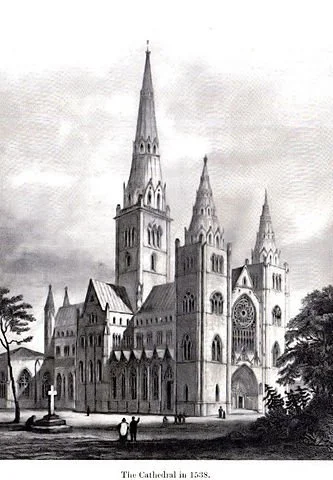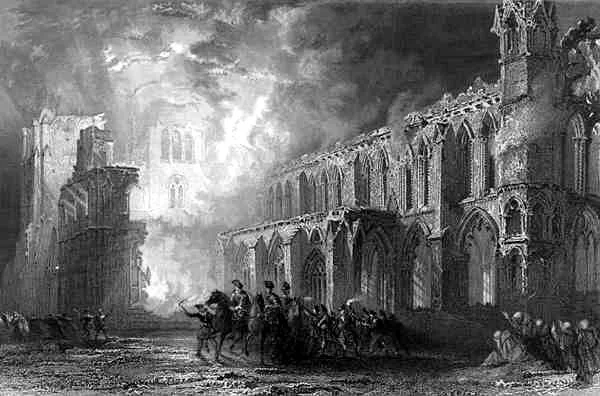Elgin Cathedral History: North East Scotland
One of the highlights in the Moray region and in the town of Elgin is Elgin Cathedral, if you are travelling in this region I would highly recommend a wee stop to see the impressive building and learn a bit about the long history attached to the cathedral.
Situated in the north east of Scotland (obviously the best area of Scotland 😉) is the 800 year old Elgin Cathedral. Positioned on the main A96 road and roughly in between the main cities of Inverness and Aberdeen, the town of Elgin is very accessible.
The History
Nicknamed the “Lantern of the North’ the cathedral is a majestic, historic ruin that has such an interesting history. The Cathedral was first founded in 1224 and was to become home to the Bishops of Moray.
A location was needed for them to set up a diocese. At the time the diocese stretched from Buckie, up to John O’ Groats and westwards over to Skye. Prior to them setting up home in Elgin, they had been in nearby Spynie Palace. However, geographically, and logistically Elgin was the better place.
It cannot be understated the power the Bishops of Moray had, the power was not only held in the church but to the feudal lords and landed estates. Elgin cathedral prior to the Reformation was such an important and powerful seat in all of Northern Scotland. The town of Elgin was wealthy and the cathedral was even used as a teaching cathedral - if a priest wanted to become a Bishop they would have to travel to Elgin.
The Fire
The twin towers that remain are the only original feature still standing, fora Scottish religious building was quite unique.
It is surprising considering the devastation which unfolded in the years to follow…
The success of Elgin cathedral was evident, so the Bishops wrote to the Pope to ask for more money to expand the building. Their request for more funds was denied and just a few months later the Cathedral had a devastating large fire that caused lots of damage… how mysterious..
After the fire they rebuilt and expanded the height and scale of the cathedral. However, the peace did not last.
The Wolf of Badenoch
In 1390, the “Wolf of Badenoch” or more formally known as Alexander Stewart set the cathedral on fire. He was the son of Robert the 2nd and did not agree with the bishops, they had issued a sentence of excommunication against him. The other reason for such hatred was that the bishops had advised his long suffering wife she should divorce him. In revenge he raised a stronghold and set the cathedral alight with such thoroughness.
He began his rampage through nearby Forres, then ransacked Pluscarden Abbey before causing destruction in Elgin and burning the cathedral to the ground.
The original west window, the nave and the chapter house were all destoryed.
Evidence of the fire was found in the 1980’s when the restoration team came across some twisted, melted sandstone. The heat needed to destroy the stone would have to exceed 200°c. The sandstone also showed signs of discoloration.
Remarkably, the twin towers remained and now it has the most medieval stone memorials than any other Scottish cathedral. I've attached an image of what experts believe the cathedral may have looked like in all it's glory.
Leading up to the reformation, a few structural changes were made and another minor turbulent incident occurred in 1555 when the Innes clan decided to fight with the Dunbar clan inside the cathedral. All that seems to have been recorded is that there were over 200 people inside battling, it is known locally as “the bloody vespers”.
The Reformation
After the Reformation of the 1560’s, the cathedral cut ties with the Pope and essentially overnight, the cathedral became obsolete. The cathedral died of neglect, with the last Bishop - Patrick Hepburn moved to live out his remaining days in the comfort of Spynie Palace.
The lead from the high roof was sold, this was ordered by the Regent Earl of Moray who instructed the removal of the roof to help pay for his army. The interiors were either looted or moved. The carved wooden pews were moved to St. Sylvester’s church.
In 1599 the Kirk Sessions forbade the use of the grounds not just for the purpose of worship but all other activities of frivolity. It’s said (in Scots) that the Kirk forbade “singing of carrelles, other profane songs, guysing, pyping, violing and danscing” Additionally, and quite particular the throwing of snowballs was also forbidden. Of course, it should be mentioned that “all women and lassies are forbidden to haunt or visit”.
Sadly overtime the once grand cathedral was left to decay. The collapse of the roof finally happened in 1711 and the entire nave also crumbled.
In the 1800’s I've read in some instances the cathedral ruins have been used for shelter for the homeless and needy. It wasn't until 1824 that the local authorities took over the cathedral and some 300 years later that care and restoration took place.
The Cathedral is now under the management of Historic Scotland. You can visit the Cathedral and tickets are £5.50.
Things to see nearby
The Biblical Gardens
Across from the cathedral is the free Biblical gardens. The peaceful gardens are open daily from May through to September. Throughout the gardens, there are sculptures that tell the story of the Bible.
Johnstons of Elgin (Cashmere and Cafe)
A stones throw away from the cathedral is the cashmere mill and clothing outlet. Dating back to 1797, they craft luxury cashmere and woollen items. You can tour the mill and see behind the scenes and learn about this craft that is so important to Scottish heritage. The mill also has a great cafe that is good for lunch or a coffee.




